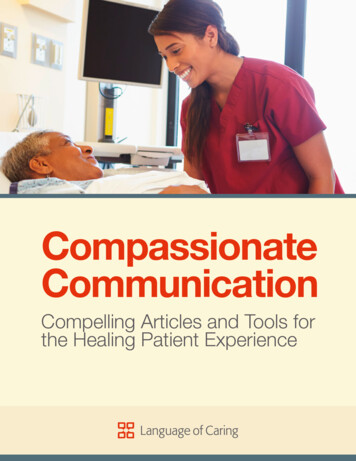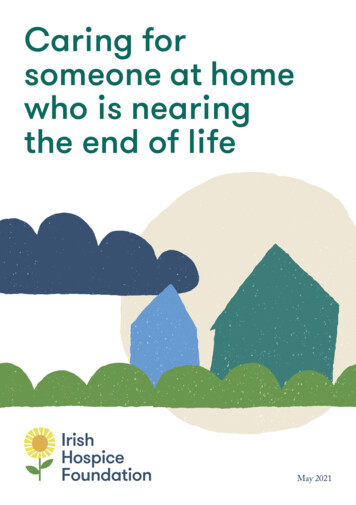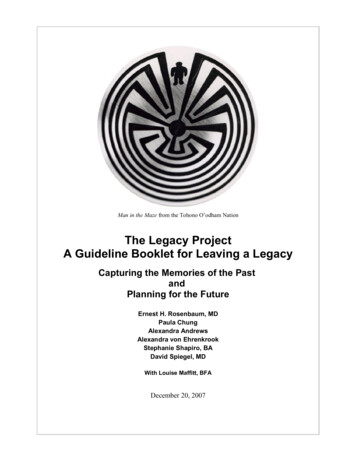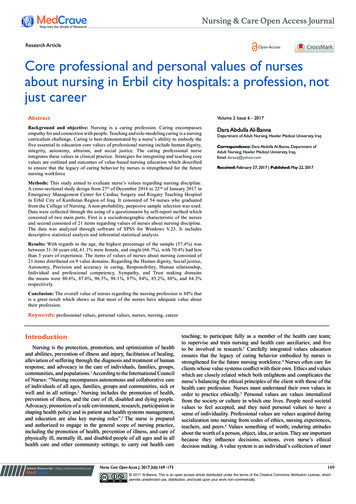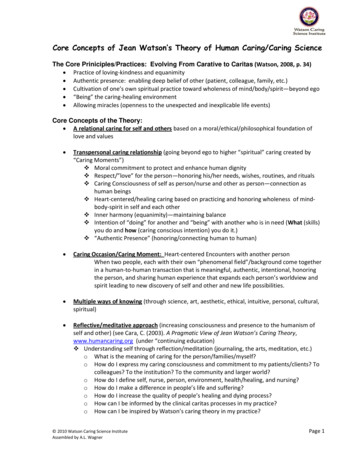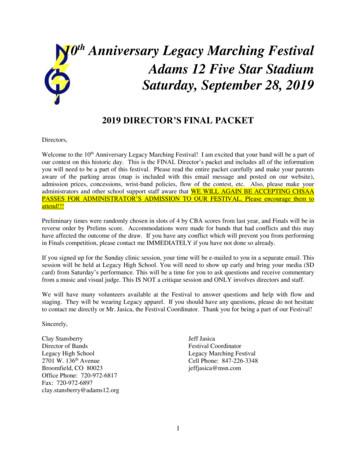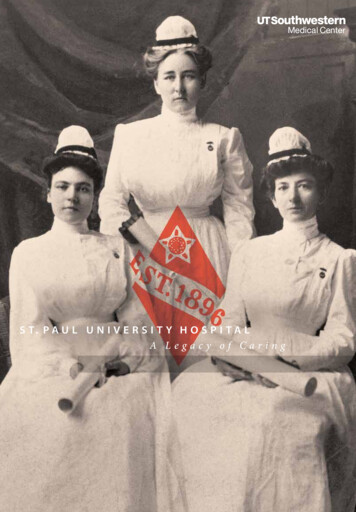
Transcription
S T. P A U L U N I V E R S I T Y H O S P I T A LA Legacy of Caring
Dear Friends,To thank you for your long-standing support of St. Paul University Hospital, we are pleasedto provide you with this special, commemorative edition of St. Paul Medical Foundation’s annualmagazine. This year, my office joined with the Foundation to produce this historic account,which chronicles St. Paul University Hospital’s singular role in Dallas over more than 100 years.From its inception in 1896 as St. Paul’s Sanitarium, through several important transitions,St. Paul University Hospital’s growth and development were inextricably tied to thecommunities it served.Created to meet the health care needs of a growing Dallas as it approached the turn of the 20thcentury, St. Paul quickly became a standard bearer for excellent patient care.As the magazine stories and photos demonstrate, caregivers were so devoted they risked theirown safety to attend to patients during the deadly Spanish flu outbreak in 1918 and again threedecades later, during a five-alarm hospital fire in 1951.St. Paul also distinguished itself by continuously broadening access to its services. Early on,the hospital offered free medical care to the poor. It later established community clinics specificallydesigned to reach immigrants and other underserved groups.The hospital opened its doors to African-American doctors in 1954, becoming the first Dallashospital to grant them courtesy privileges, and then, in 1956, after African-American doctorswere allowed to join the Dallas County Medical Society, the first to grant them staff status.Among other noteworthy “firsts,’’ in 1985 St. Paul was the first hospital in Dallas to successfully complete a heart transplant. The hospital became a major center for transplantationand a recognized leader in stroke care and other specialties.By any standard, St. Paul’s legacy, which will live on at UT Southwestern’s new William P.Clements Jr. University Hospital, is a point of pride for Dallas. We hope you enjoy this keepsakemagazine as a tribute to one of our most cherished institutions.Table of ContentsFounding years: 1896 to 19502Building a reputation: 1951 to 19629Endings and beginnings: 1963 to 198417Evolution of a hospital’s spirit: 1985 to 201425Cover photoFirst graduates of the St. Paul’s Sanitarium Training School for Nurses, 1903Sincerely,Daniel K. Podolsky, M.D.President, UT Southwestern Medical Center
St. Paul’s Sanitarium, operated by theDaughters of Charity of St. Vincent de Paul,opens a temporary hospital in a cottageon Hall Street in Dallas to serve patientsuntil the inaugural hospital is built.1896
Hospital staff treat soldiers fromCamp Dick, an Army aviationtraining facility then located at theState Fairgrounds, during the fluepidemic of 1918. As the hospitalFoundingsurpassed its capacity, 45 tentsyears : 1896 to 1950were set up on the lawn toat least 15 lives at St. Paul’s, includingtwo hospital employees: a pathologistaccommodate the overflow.and a 21-year-old nursing student.In a letter that reads like the report ofThe Spanish flu epidemic struck Dallasand finished nearly a month later duea military victory, U.S. Army Col. Johnwith a fury. After every bed, porch,to the crush of work.McReynolds applauded St. Paul’s forand corridor in St. Paul’s Sanitariumits selfless aid to sick soldiers.was filled with sick citizens and soldiers,beds lined up wherever one could45 tents were set up outside to accom-be put, porches, corridors, and all roomsium maintained an attitude of sympathymodate the overflow. The Daughters ofoccupied. Sister Martha was movedand cooperation with the governmentCharity of St. Vincent de Paul, whoto tears at the sight of poor soldiers lyingwhich never wavered throughout thehad opened the hospital in 1896, sacri-on the ground while waiting for beds,”struggle but steadily grew in force andficed sleep and their own health to helpshe wrote of the care that hospital staffefficiency until the final victory wasthose they could.members provided to 1,500 soldierswon,” he wrote. “This spirit of conse-from nearby Camp Dick, an Army avia-crated service prevailed in every part oftion facility at the State Fairgrounds.the institution.”Sister Mary Michael, one of thenuns assigned to the hospital, matterof-factly described the chaos in a lettershe began writing Sept. 29, 1918,19181“It was surely a sad picture to see2As World War I dominated world“From the beginning, the sanitar-Throughout St. Paul Universityheadlines, St. Paul’s dealt with itsHospital’s 118-year history – despite aown tragedies that fall. The flu claimedseries of name, ownership, and location
changes – one constant has been thatmore than two decades. “There’s stillas saying that “St. Paul’s Sanitarium isspirit of exceptional service.that sense of the provision of excellentthe finest hospital in the world,care and service to patients, even ifhaving all that is modern in equipmentthey can’t pay for it.”and appliances.”“The St. Paul spirit of service willcontinue, though some things willchange with the transition to the newThose roots of service date back toThe hospital reflected the latest inWilliam P. Clements Jr. University1896, a time when the city of Dallasfeatures for its time, such as eleva-Hospital,” said the Rev. Pat Hanser, whowas growing and in desperate need of ators, electric and gas lights, radiators,served as a chaplain at St. Paul fornew hospital. Back then, City Hospitalfireplaces, dumbwaiters, and bathroomswas the only medical center to servewith hot and cold running water.Dallas’ population of 37,000. SeveralSoldiers pose with nurses andDaughters of Charity sisters on thesteps of St. Paul’s Sanitarium onBryan Street in 1918.Children are examined by a Daughters of Charity nursing sister and weighedby a nurse in St. Paul’s Marillac Clinic in 1942. The clinic served theSpanish-speaking community.Eventually, an agreement wasprominent Dallas physicians and busi-reached in which the Daughters ofnessmen appealed to Bishop EdwardCharity paid 1 for land purchased by aJoseph Dunne of Dallas to encouragecitizens’ group. The first two sistersThat same month, a temporaryAn elaborate public ceremony markedhealing properties. A listing in thethe Daughters of Charity to open atraveled by covered wagon some 1,200hospital opened in a small cottage onits debut, including a blessing by theDallas Social Directory said costs forhospital. The Daughters of Charity, amiles from Maryland to Texas thatthe property.Bishop of Dallas, High Mass in thecare ranged from 1 to 5 per day andRoman Catholic women’s order thatJune. By November, ground was brokenhospital’s chapel, and speeches by citythat the aim of the sisters was to “relieveoperated several other hospitals at thefor the original three-story, 110-bedsisters’ arrival for the castle-like redleaders. In a local news report on thesuffering humanity, regardless of faith.”time, was ingrained with a mission ofhospital at Hall and Bryan Streets.brick and stone hospital with tall ceil-opening, Dr. Samson Eagon was quotedcharity to serve the sick and the poor.1918Stately Victorian-style verandas allowedsunshine, believed to have importantIt took nearly two years from the19361942A 1936 surgery at St. Paul’s Hospital is observed by studentnurses, with a nursing sister in the background.4Throughout the years, the sistersserved the poor. In 1906, a free clinicings and archways to be completed.3patients to benefit from fresh air and
was set up in the hospital’s basement.article, “he was near death fromSister Brendan O’Beirne, in chargestarvation. I fed him with a spoon andWar II, a group of women founded theof that operation, felt passionate abouthe’s never forgotten.”Women’s Auxiliary of St. Paul’s Hospital.her mission. Often she would visitDuring 1920, some 10,000 peopleIn 1943, at the height of WorldThey initially made pajamas, sheets, andpatients in their homes, offering what-were cared for in the clinics, mostlypillowcases for patients, later becomingever they needed, whether it wasMexican immigrants who were withouta key hospital support group of womenfood, clothing, or medicine. The clinicsufficient resources and who poured– and men – who not only volunteeredeventually had a building of its own,into Texas after World War I. A fewtheir time but also raised money for St.and a second free clinic, the Marillacyears later, the Marillac Social CenterPaul’s through the operation of a thriftClinic, later opened to serve residentswas added, an expansion of the clinicstore and hospital gift shop.in the predominantly Hispanic “Littleprogram that offered recreational andMexico” neighborhood of Dallas. Oneducational programs.Meanwhile, a major hospitalopening day of the Marillac Clinic inkeep pace with the city’s growth. ThisPaul’s capacity to 475. But as construc-height of St. Paul’s to five stories. Thisaddition, called the Annex Building,tion wound down in late 1951, a disas-photo, from 1945, shows theelevated the structure’s height to fiveter threatened to destroy everything thestories and added about 200 beds. Insisters and other hospital staff had spent1927, it was renamed St. Paul’s Hospital.more than a half-century building.A major hospital expansioncompleted in 1916 elevated thehospital a few years before construc-“When I first saw him,” Sistertion of its final addition in 1950.Brendan recalled in a 1939 newspaper19455The Dallas Building, a 1.5 millionaddition begun in 1950, increased St.1,000 people. Among those servinghelped earlier by Sister Brendan.more patient beds continued to grow.expansion was completed in 1916 to1920, soup was served to an estimatedsoup was a hospital kitchen employeeAfter the war ended, the need for6
St. Paul’s School of NursingA postmarked, yellowed envelope glued to a scrapbook page contained a treasuredletter from Billie Thompson’s father. In it, he wrote how proud he was of his daughterbecoming a nurse.“As you were marching in, the thought ran through my mind how proud yourmother would have been of you. I had a hard time keeping the tears back,” he wrote ofher graduation from St. Paul’s School of Nursing on Feb. 18, 1947.Other mementos of Billie Thompson’s three-year education at St. Paul’s dotted herribbon-bound book with a U.S. cadet nurse patch glued to the cover: nursing boardexam grades, photos of the hospital, thank-you notes from patients, birthday cards fromrelatives and suitors, a printout of the school’s song, a nursing school graduation program, and the school-color ribbons she wore at graduation.These glimpses into a student’s life provide valuable clues of how St. Paul’s nursingprogram transcended an educational experience. For the 1,709 students who graduated from St. Paul’s School of Nursing during its 71 years of operation, affection ran high.In the early years, the hospital was the students’ whole world – they studied, lived, andworked there. A sorority-like atmosphere, with activities ranging from dances to cappingceremonies, engendered closeness.The unique culture of St. Paul’s Hospital, including its nursing school, is grounded inthe service-oriented mission of the Daughters of Charity. Originally called the St. PaulSanitarium Training School for Nurses, the school was established in 1900, just four yearsafter the hospital opened. It operated until 1971, when the final class of 12 nursingstudents graduated.Although the nursing program was beloved by the Daughters of Charity, decliningenrollment and an industry trend toward university degree programs prompted St. Paul’s19 4 7to discontinue its three-year program. The average senior class size was 22, peaking at199 graduates in 1949. Although the majority of students were women, 17 men gradu-Billie Thompson, who graduated from St. Paul’s School of Nursing in 1947, compileda scrapbook while attending the nursing school that operated for 71 years.Shown here are Ms. Thompson and a copy of the Florence Nightingale Pledge, anadaptation for nursing of the Hippocratic Oath for physicians.ated from the nursing school through the years.78
Buildingareputation : 1951 to 1962Fifteen minutes after midnight on Oct.Years later, Dallas officials still24, 1951, an odd odor awoke Sistermarveled at Sister Alberta’s exemplaryAlberta Savage. It was smoke, accom-leadership during the fire. At a 1964panied by an ominous red glow on thededication ceremony for what wouldceiling of her fifth-floor hospital bed-become the new St. Paul Hospitalroom. Within the hour, a fire that hadbuilding at Harry Hines Boulevard andbegun in the attic exploded into a five-Inwood Road, C.A. Tatum Jr. describedalarm blaze that threatened St. Paul’sthe hospital administrator’s heroicHospital – and, worse, its patients.actions that night.Keeping a calm demeanor instilled“Sister Alberta called the safein her by the Daughters of Charity’sevacuation a miracle. It was that – andservice-focused mission, Sister Albertamore. It revealed that in the face ofquickly implemented an evacuationtrouble or disaster, our people can workplan that saved the lives of more thanwith one will, one mind, and one heart250 patients and employees.1951A five-alarm fire breaks out on thehospital’s top floor. More than250 patients are safely evacuated,with no casualties reported.910
toward a single goal,” said Tatum, whoserved as Chairman of the St. Paulan overheated pipe, the fire causedHospital Advisory Board at the time. 125,000 in damage but did not keepFortunately, only a few weeksthe hospital from reopening less thanprior to the blaze, Sister Alberta hadapproved a fire safety plan. She hadThe safe evacuation of patients from St. Paul’s Hospital thenight of the Oct. 24, 1951, fire grabbed newspaperheadlines across the country. Despite 125,000 in damage,the hospital reopened within 24 hours.Believed to have been caused by24 hours later.The fire was the first of manytelephone operator Mary Jo Wilsonturbulent events – some of them heroicnotify the Dallas Fire Department, thenmilestones – affecting St. Paul’s duringroused other sisters to assist with a hos-the 1950s as it evolved into an admired,pital evacuation. Per the fire protocol,increasingly service-oriented hospitalthe hospital fire alarm code, “Emer-catering to a diverse patient populationgency – Doctor Red,” was announcedin an era of medical breakthroughs.over a public address system. Within 20As repairs to the fire-damaged mainminutes of a fire chief ’s command for ahospital building began, constructionfull evacuation, all patients were safelycontinued at the Dallas Building, themoved outside and then temporarilythirteenth and final addition to thetransferred to area hospitals.Bryan Street hospital complex. The 1.5million, six-story facility, which added19511951Volunteer rescuers evacuate apatient on a mattress fromSt. Paul’s Hospital during theOct. 24, 1951, fire.1112Dallas Morning News staff photo
Champions of DesegregationWhen St. Paul’s Hospital permitted African-American doctors to practice there in 1954, an erasteeped in racial discrimination, it sent a ripple through the city, eventually serving as a catalystfor change.95 beds and 80 infant bassinets, openedbrothers living in Dallas at the time –in April 1952. In a newspaper articleJoe, John, and Henry Jr. – who operatedsense demeanor would make Sisterpublished that month, Sister Alberta’sa meat-packing plant.Mary Helen a catalyst for change inleadership style was described as tradi-Over the years, the Neuhoff familyFor the Daughters of Charity of St. Vincent de Paul, it didn’t seem that big of a stretch fromThat compassionate yet no-non-their original mission to serve the sick and the poor regardless of religion, nationality, orrace. A front-page newspaper article heralded the milestone: “Negro MDs to Practice in St. Paul’s.”A month earlier, in the landmark case Brown v. Board of Education, the U.S. Supreme Courtan era of institutional segregation.had ruled public school segregation unconstitutional.tional yet progressive. As an example,would become key supporters of St.When she joined St. Paul’s in 1953,the article noted that St. Paul’s was onePaul’s Hospital, contributing bothAfrican-American physicians were notof the first hospitals at that time to ad-time and resources. The son of Henryallowed to practice in the hospital,mit alcoholic patients, with five roomsNeuhoff Jr., Henry Neuhoff III, and hisand black patients were treated in thededicated to their care.wife Kay, an Emeritus Director of thehospital basement. Segregation wasSt. Paul Medical Foundation and a for-the norm at major Dallas hospitals –Alberta told the newspaper reporter.mer St. Paul Auxiliary member, recalledbasically there were “white” hospitals“We want to help them if they want us to.”Sister Mary Helen as a business-and “black” clinics.“They really are sick people,” SisterThe following year, when SisterAlberta became ill and resigned, Sisterwoman in a nun’s habit “who couldmove mountains.”stand. In 1954, St. Paul’s became thewas named hospital administrator. Onebody knew it,” Henry Neuhoff III saidfirst Dallas hospital to give African-Nashville, Sister Mary Helen had threeBut, his wife added, she was alsowas among the first five black doctors to work at St. Paul’s.Change did not come easily, however. Because St. Paul’s requiredphysicians to be members of the Dallas County Medical Society foradmission to the staff, the first black doctors could receive only courtesyprivileges. In 1953, Dr. Emerson Emory became the first AfricanAmerican to intern at the hospital.In 1954, African-Americans were barred from becoming membersintegration, Sister Mary Helen took a“She ran a tough ship, and every-of his late aunt.recalled Julia Jordan in 2010. Her husband, the late Dr. Frank Jordan,As the nation moved slowly towardMary Helen Neuhoff, of St. Louis, Mo.,of nine children of Henry Neuhoff Sr. of“It was amazing. Nobody stood in their way. Nobody picketed,”of the medical society, although that rule changed the followingyear. Taking the lead again, St. Paul’s in 1956 became the first DallasAmerican physicians courtesy privilegesto practice in the hospital. In 1955,“very caring and loving.”In 1954, St. Paul’s Hospital became the first hospitalin Dallas to give courtesy privileges to AfricanAmericanphysicians to practice in the hospital.“I think everybody was judged by their competence. I don’tStanding left to right are Dr. Frank Jordan,remember anyone being prejudiced because of skin color,” saidDr. Joseph Williams, Dr. William Flowers, andDr. George Shelton. Seated is Dr. Lee Pinkston.Dr. Pat Jenevein, a retired Clinical Professor of Pathology at UT South-hospital to add black physicians as hospital staff members.western who began working at St. Paul in 1965.Dr. Emmett Conrad, the first African-American surgeon on staff at St. Paul, became the firstblack Chief of Staff in 1980. His leadership extended to city government; he was the first AfricanAmerican elected to the Dallas school board in 1967, and he played an important role incombating segregation in the city. Dr. Conrad, who died in 1993, was honored by the TexasHistorical Society for outstanding achievement. In 1986, his portrait was hung in Dallas CityHall as a Living Legend.13141954
As the decade drew to a close,Dr. Morris described Sister Mary Helen’sproject would be funded by federalSt. Paul’s internship, residency, andforward-looking beliefs on racialSt. Paul’s began running out of space,grants and by the Daughters of Charity.other medical education programs.equality as reflecting the sisters’ values.but rather than planning yet anotherAt the time, the Southwestern MedicalUnfortunately, the sisters’ aspirations“I think she felt that it was part ofaddition, a fund drive for a brandDistrict was in its infancy but growing,were not to be realized because the oldher mission as a Daughter of Charity tonew hospital was launched in 1958 bywith Parkland Hospital and Southwest-hospital was ultimately razed.recognize that all people are createdSouthwestern Medical Foundation.ern Medical School already in place.equal, and that if they have the properThe campaign was led by philanthropistLand for the new St. Paul Hospital onrenamed hospital. Significantcredentials, they should be allowed toKarl Hoblitzelle, who has been a majorHarry Hines Boulevard was donatedadvancements in medical care andpractice in the hospital.”benefactor of St. Paul’s and UT South-by the Catholic Diocese of Dallas andgrowth at St. Paul would be juxtaposedwestern Medical Center throughSouthwestern Medical Foundation.against poignant endings over the nextAt the same time, St. Paul’s was atIn 1962, two sisters of St. Paul’s Daughters of Charity order, along with anunidentified man, observe progress on the steel frame of the new St. Paul Hospitalunder construction on Harry Hines Boulevard. The hospital opened in 1963.the vanguard of clinical care. On Sisterthe years. He and his family contributedMary Helen’s watch, the hospital staffSt. Paul’s School of Nursing admittedembracing racial equality in Dallas.its first black students. In 1956, St.In 1963, St. Paul unveiled its newlyThe sisters initially thought theytwo decades, including the closure of 250,000 toward the campaign’swould convert the old hospital on Bry-St. Paul’s 71-year-old nursing school.in 1957 successfully performed its first 4 million goal. In appreciation of thean Street into a center for convalescent,The late Dr. Charles Morris, St. Paul’sopen-heart surgery and then, in 1959,donation, a two-story clinic attachedchronic, and geriatric patients, nearlyPaul’s became the first Dallas hospitalfirst medical director, worked with Sisteropened the city’s first intensive careto the hospital was named in honordoubling the capacity when added toto admit black physicians to its staff.Mary Helen during her tenure fromunit. The ICU embodied the growingof Mr. Hoblitzelle’s late wife, Esther.the proposed new 484-bed hospital.1953 to 1961. Upon her death in 1992,trend of “progressive care” in which pa-The balance of the 10 million hospital“The combined facilities will make St.Finally, in 1959, the hospital endedracial segregation of patient-care areas,tients were grouped by degree of illnessPaul Hospital the largest of its kind incontinuing its leadership role ofrather than by disease type.the South,” stated a 1958 brochure on1962In addition to their work in the hospital, theDaughters of Charity often assisted underservedfamilies in the community. Here, in 1962, SisterAlice Huth visits a low-income mother and childas part of St. Paul’s community outreach.1516
Ending sandbeg inning s: 1963 to 1984to check each patient personally.Through this seamless move, St. Paulstaff demonstrated the keen attention topatient care that has been its hallmark.The sun had been up less than two“It was exciting to see, becausehours on Dec. 22, 1963, when a caravaneverything at the new hospital was soof 10 ambulances, two trucks, and amodern,” recalled James Campbell, anlimousine rolled up outside the old St.orthopaedic technician who had workedPaul’s Hospital on Bryan Street. Bitterlyat St. Paul since 1961. “The old hospi-cold temperatures and Dallas’ firsttal looked like a castle, but a lot of thesnowstorm of the year threatened tosections were running down. We werederail carefully laid plans to move allpatients the estimated four miles to thenew St. Paul on Harry Hines Boulevard.Doctors and nurses bundled upBabies in incubators are loaded into aheated panel truck for the move to thenew hospital.Within five hours, 96 adult patientsglad to get to a new place.”Indeed, the new 10-story hospitalreflected the latest in medical technology and patient care. Built, equipped,patients and accompanied them in am-and 16 babies had been transferredand furnished at a cost of 15 million,bulances. A van carried two orthopae-without incident. Sister Elizabeththe 484-bed hospital boasted such inno-dic patients, while a heated panel truckSteiner, the hospital administrator, keptvative features as circular intensive caretransported newborn babies.watch at the emergency room entranceunits and the best X-ray technology19631963A patient in an orthopaedic bed istaken off a truck at the new St. PaulHospital after the ride from the oldhospital building on Bryan Street. Thepatient was one of 112 moved on thebitterly cold day of Dec. 22, 1963, as thehospital opened at its new location.1718
St. Paul Medical FoundationWithout strong community support, St. Paul University Hospital’s evolution as a serviceoriented medical center offering the best in care might not have been accomplished.For the last half-century, a primary supporter of the hospital has been St. Paul MedicalFoundation, founded in 1964.craftsman to design the mosaics.Originally called the St. Paul Hospital Endowment Fund, the organization’s purposeDedication day was a huge causewas to support medical and hospital care with special emphasis on care for the un-for celebration. More than 1,000 peoplederserved, and to support medical research and education in line with the values andattended the ceremony, which includedmission of the Daughters of Charity.tours of the hospital. Roman CatholicMany varied and worthwhile projects have been funded and endowed to ensure aChurch dignitaries and local politicalsteady stream of resources at St. Paul to accomplish the Foundation’s mission, whichleaders spoke, including a filmedhas remained essentially the same over the years. That effort has been due in no smallcongratulation from then-Texas Gov.part to the participation of many dedicated and highly respected community leaders.St. Paul Hospital named its executive suite the Kennedy Suite in honor of thepresident who was assassinated in Dallas on Nov. 22, 1963, just a month beforethe new hospital opened on Harry Hines Boulevard. In this photo,from 1964, a nurse gazes out the suite’s window.Among those who served in the earliest years were Joe Haggar Jr. and Trammell Crow,followed by Mrs. John (Lupe) Murchison and Jere Thompson in the ’70s; Maurice Acers,Robert Crandall, Annette Strauss, and Rita Clements in the ’80s; and Stanley Marcus,Mary Kay Ash, and Ebby Halliday Acers in the ’90s.During the 1990s, serious budget deficits afflicted the hospital. In the early 2000s,the Foundation stepped in to provide much-needed aid in the form of a 1 million grantto help underwrite the fees of a management consultant and a second 1 millionrecapped Sister Elizabeth’s speech.used in the hospital’s construction.upscale feature, including one namedThey included marble and walnutpoured more than bricks and mortar.in honor of President John F. Kennedy,paneling in the lobby, a different typeThere is a combination of love, devo-who had been assassinated in Dallasof marble in each elevator foyer,tion, time, talents, and substance, toone month earlier.and beautiful wall mosaics depictingwhich everyone has contributed. This iscorporal works of mercy fromwhat is unique about St. Paul,” she said.In keeping with the sisters’ highstandards, only the finest materials weretals. That same year, the Foundation merged with its sister organization – the St. Paulthe Bible. New York artist Allyn Coxworked with a Venetian mosaicFund for Advanced Heart and Lung Disease.In recent years, the Foundation’s signature fundraising events – the Legends Gala and19 6 4Transplant Tee golf tournament – have raised millions of dollars to support heart, lung,vascular, and cerebrovascular programs at St. Paul and UT Southwestern. The organizationalso sponsors a support group called Friends of the Heart, Lung, and Vascular Programsat UT Southwestern Medical Center.With the opening of the new William P. Clements Jr. University Hospital and thedecommissioning of St. Paul, the St. Paul Medical Foundation, in supporting activities atUT Southwestern, will continue to champion the values and the tradition of care itsupported so generously over the years at St. Paul University Hospital.19the hospital’s employee publication,on the market. Executive suites were angrant for bridge loans. This support enabled the hospital to stay viable until January 1,2005, when UT Southwestern Medical Center acquired St. Paul and Zale Lipshy Hospi-John Connally. The St. Paul Post,20“Into our new St. Paul has been
The new hospital established itsas to support medical research andHospital construction lastedIn October 1964, St. Paul Medicalfirst addition, in 1974. Three years later,education. Through the years, the Foun-own reputation for innovations inalways a big educational effort at St.a 5 million campaign was launched,dation has provided critical assistancepatient care. In 1962, St. Paul becamePaul, which had one of the best surgicalpartially funding a 12 million expan-for St. Paul programs and patients,the first hospital in Dallas to alloweducational programs for residents insion that included an eight-storyan effort that broadened to includefathers into the delivery room and, inthe city,’’ said Dr. Jenevein, who nowpatient tower and one-story cancerZale Lipshy University Hospital and1967, the first to open coronary careserves as a Director of the St. Paul Med-center that were completed by 1982.the William P. Clements Jr. Universityunits. Also in the 1960s, the hospitalical Foundation.Hospital, which opened in late 2014.acquired a high-pressure oxygenAs St. Paul grew, the 1960s usheredEbby Halliday and The Four Tops at the Foundation’s 2001 Legends Gala, one of manyspecial events that have raised funds for excellence in medicine.“The 1960s were fun. There wasHe credited Dr. Ernest Poulos,The late Joe Haggar Jr., formerPresident of Haggar Clothing Co.,chamber to treat patients for cancer,former Emeritus Director of Surgicalhelped fund construction of the patientin new ways of thinking about medicalgangrene, carbon monoxide exposure,Training, and the late Dr. Williamtower, named in honor of his parents,care that required taking a critical lookand bacterial sho
served the poor. In 1906, a free clinic 4 1918 1936 1942 Soldiers pose with nurses and Daughters of Charity sisters on the steps of St. Paul's Sanitarium on Bryan Street in 1918. Children are examined by a Daughters of Charity nursing sister and weighed by a nurse in St. Paul's Marillac Clinic in 1942. The clinic served the

